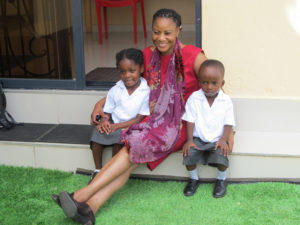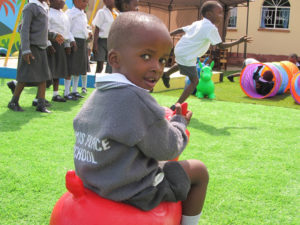Preschoolers in Lusaka learn & play their way to school readiness
By Jillian SlutzkerMay 2, 2016
Lusaka, Zambia—Three-year-old Chiyanjamo Nyirenda has taken some big steps since early March when he first walked through the doors of Mimi’s Place, a first of its kind early childhood education center using The Creative Way methodology.

The once quiet boy who knew no English is now babbling with his classmates and 5-year-old sister in English, writing numbers and coloring within the lines, says his mother. Moreover, he is thrilled to go to school each day.
“After one month, I noticed a lot of changes. Now he seems like a grown man. He does everything on his own,” says his mother, Barbara Banguna, Monitoring and Evaluation Officer for USAID’s Read to Succeed project, which is implemented by Creative Associates International.
The Creative Way is designed to build children’s self-confidence and utilize their innate predisposition for learning. The methodology provides guidelines for the physical space of the learning environment, as well as teaching pedagogy, curriculum and learning assessments.
“When we were told how [Mimi’s Place] would develop children I became interested, especially with my three-year-old,” says Banguna. “He has been helped a lot and we are talking about just one month. If he does six more months, there will be a lot of changes.”
Providing quality education close to home
In its pilot phase, Mimi’s Place provides learning opportunities for 3 to 6 year olds of Read to Succeed project staff, which will boost the chances of their children’s success in school. The center is part of a larger strategy and commitment by Creative to recognize and support local staff and families. Mimi’s Place is not affiliated or endorsed by the U.S. Agency for International Development.
“I’ve never heard of anything like this before in the places I’ve worked. Never,” says Banguna.
Wamuki Imasiku, Procurement and ICT Officer for USAID Read to Succeed and father of 3-year-old Catherine, has seen Creative’s literacy education transformation efforts across six Zambian provinces. Based on that programmatic work, he was confident in the quality of education Creative’s Mimi’s Place would provide his daughter.
“When they talked about opening a school here for the Read to Succeed staff’s children, I knew it would be an example of what Read to Succeed has been doing,” he says.
Playing & learning for school readiness

The Creative Way methodology aims to prepare young learners for entering first grade. Pre-school is now a national requirement in Zambia, but the quality of that education varies, say Mimi’s Place instructors.
Within the colorful walls of Mimi’s Place, however, instructors emphasize problem solving and independent thinking, so these curious young minds can learn through exploration and play.
“Mimi’s Place methodology is quite interesting in that children can express themselves…they do that critical thinking,” says Assistant Teacher Yvonne Sakala, who is trained in the Creative Way methodology. “It’s so exciting that the children have an interest in learning.”
Using resources like puzzles, educational tools, outside exploration and asking children questions, the educators guide their students through a hands-on engaging learning process where they discover new things on their own and begin to find solutions to problems.
“Here we use a lot of resources to get them to start thinking,” explains Head Teacher Gertrude Chitanda, pointing out colorful puzzles and educational toys around the classroom. “Now they are thinking on their own.”
She says her young learners have already progressed from knowing no English, in some cases, or hardly recognizing letters to sounding out words. They are making great strides and are on their way to being very well prepared for primary school.
“This is giving me more hope that by the end of the next term they can read a sentence, and by the time they go to grade one they’ll be able to read,” she says.

